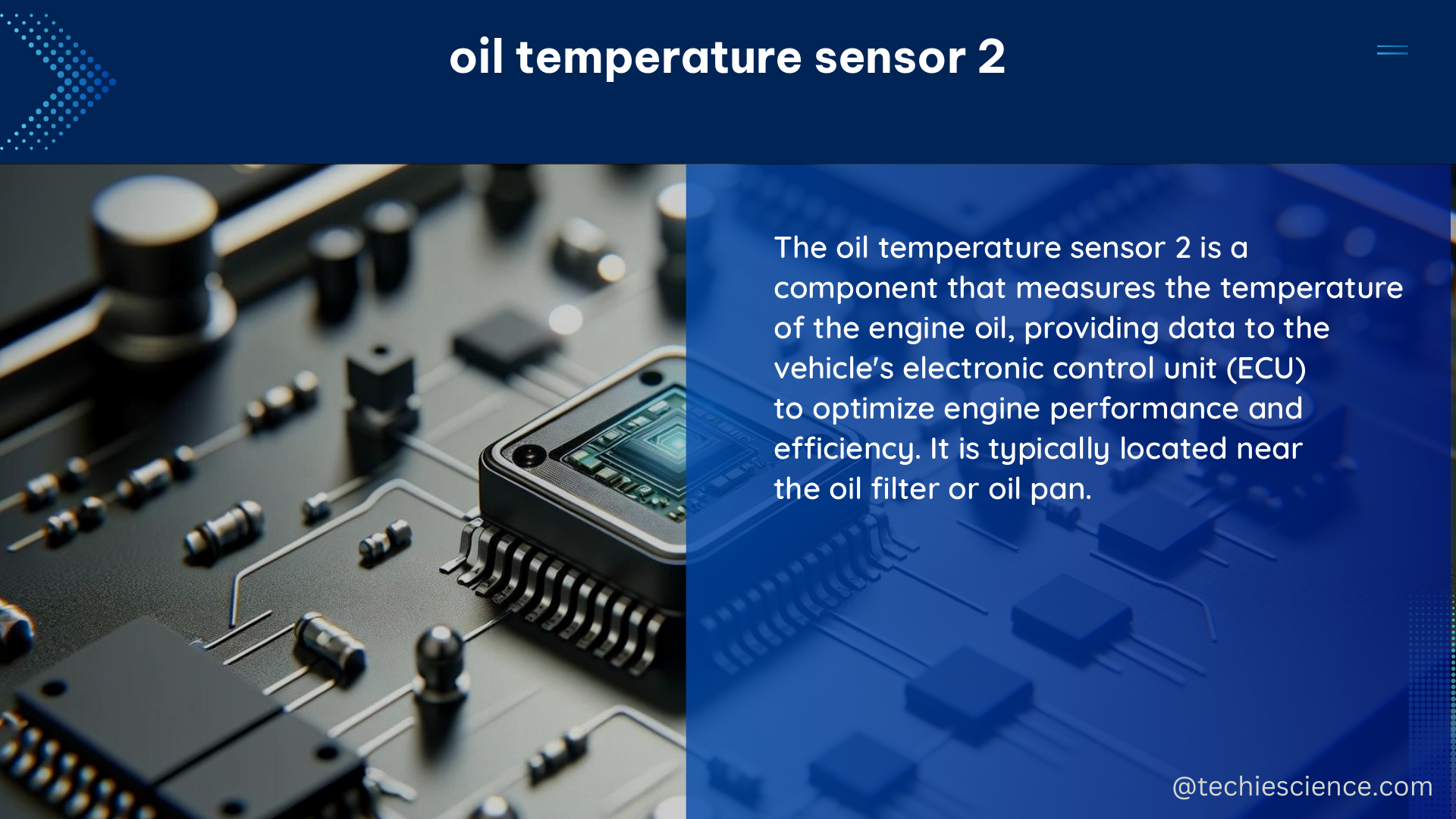The oil temperature sensor 2 is a critical component in monitoring the temperature of oil in various industrial, automotive, and power generation applications. This sensor plays a vital role in ensuring the optimal performance and extended lifespan of these systems by providing accurate temperature measurements, which can be used to adjust operating conditions and prevent overheating.
Technical Specifications of Oil Temperature Sensor 2
- Measuring Range: The oil temperature sensor 2 can measure temperatures ranging from -40°C to +125°C with an accuracy of ±0.1°C, ensuring precise monitoring of oil temperature across a wide spectrum of operating conditions.
- Fluid Compatibility: The sensor is designed to be compatible with both mineral and synthetic oils, making it versatile for use in a variety of applications and industries.
- Voltage: The sensor operates on a voltage range of 9-24 VDC, providing flexibility in power supply options and allowing for easy integration with existing systems.
- Maximum Fluid Pressure: The oil temperature sensor 2 can withstand a maximum fluid pressure of 50 bar, ensuring its durability and reliability in high-pressure environments, such as those found in industrial machinery and power generation systems.
- Protection Class: The sensor has a protection class of IP 67, indicating its resistance to dust and water ingress, making it suitable for use in harsh environments where exposure to contaminants is a concern.
- Interface: The oil temperature sensor 2 features a Modbus RTU / 4-20 mA interface, enabling seamless integration with monitoring and control systems, allowing for real-time data acquisition and analysis.
Advanced Features and Capabilities

- Thermal Shock Resistance: The sensor’s design incorporates advanced materials and construction techniques that provide exceptional resistance to thermal shock, ensuring accurate and reliable temperature measurements even in applications with rapid temperature fluctuations.
- Corrosion Resistance: The sensor’s housing and internal components are engineered to withstand exposure to a wide range of corrosive fluids and environments, enhancing its longevity and reliability in demanding applications.
- Vibration Resistance: The sensor is designed to withstand high levels of vibration, making it suitable for use in industrial machinery and automotive applications where vibrations are a common challenge.
- Electromagnetic Compatibility (EMC): The oil temperature sensor 2 is designed to comply with strict EMC standards, ensuring it can operate reliably in environments with high levels of electromagnetic interference without compromising its performance or accuracy.
- Diagnostic Capabilities: The sensor incorporates advanced diagnostic features, such as self-monitoring and fault detection, allowing for proactive maintenance and early identification of potential issues, minimizing downtime and maximizing system uptime.
DIY Installation of Oil Temperature Sensor 2
- Sensor Placement: Carefully identify the optimal location for the sensor installation, ensuring it is positioned close to the oil supply line and has adequate space for the sensor and its connections.
- Wiring Preparation: Prepare the sensor by connecting the wires to the appropriate terminals on the sensor, following the manufacturer’s instructions to ensure a secure and reliable electrical connection.
- Sensor Installation: Install the sensor in the selected location, taking care to securely fasten it and properly align it with the oil supply line to ensure accurate temperature measurements.
- System Integration: Connect the sensor wires to the monitoring or control system, ensuring a proper electrical connection and verifying the compatibility of the sensor’s interface with the system’s requirements.
- Sensor Validation: Test the sensor to ensure it is functioning correctly, providing accurate temperature readings within the specified range and meeting the system’s performance expectations.
Maintenance and Troubleshooting
- Periodic Inspection: Regularly inspect the oil temperature sensor 2 for any signs of wear, damage, or contamination, and clean the sensor as necessary to maintain optimal performance.
- Calibration: Periodically calibrate the sensor to ensure its accuracy remains within the specified tolerances, following the manufacturer’s recommended calibration procedures and using appropriate calibration equipment.
- Troubleshooting: If the sensor is not providing accurate or reliable temperature readings, follow the manufacturer’s troubleshooting guide to identify and address any issues, such as wiring problems, sensor malfunctions, or system integration conflicts.
- Replacement: If the sensor is found to be faulty or beyond repair, replace it with a new oil temperature sensor 2 that meets or exceeds the original specifications to maintain the system’s performance and reliability.
Conclusion
The oil temperature sensor 2 is a critical component in monitoring and maintaining the optimal performance of industrial machinery, automotive engines, and power generation systems. By understanding its technical specifications, advanced features, and proper installation and maintenance procedures, users can ensure the longevity and reliability of their systems, minimizing downtime and maximizing productivity.
References
- DEPARTMENT OF DEFENSE STANDARD PRACTICE – CADE. (2022, May 13). Retrieved from https://cade.osd.mil/Content/cade/files/coplan/MIL-STD-881F_Final.pdf
- Martechnic® – OIL QUALITY MANAGEMENT. (n.d.). Retrieved from https://www.martechnic.com/pdf/catalogue.pdf
- 40 CFR Part 98 — Mandatory Greenhouse Gas Reporting – eCFR. (n.d.). Retrieved from https://ecfr.gov/current/title-40/chapter-I/subchapter-C/part-98

The lambdageeks.com Core SME Team is a group of experienced subject matter experts from diverse scientific and technical fields including Physics, Chemistry, Technology,Electronics & Electrical Engineering, Automotive, Mechanical Engineering. Our team collaborates to create high-quality, well-researched articles on a wide range of science and technology topics for the lambdageeks.com website.
All Our Senior SME are having more than 7 Years of experience in the respective fields . They are either Working Industry Professionals or assocaited With different Universities. Refer Our Authors Page to get to know About our Core SMEs.